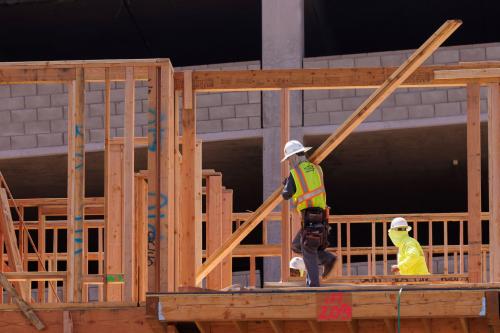Announcements of new federal regulations on the use of program-related investments (PRIs) and the launch of a groundbreaking fund in Chicago are the latest signals that impact investing, once a marginal philanthropic and policy tool, is moving into the mainstream. They are also illustrative of two important and complementary paths to institutional change: fast-moving, collaborative local leadership creating innovative new instruments to meet funding demands; federal regulators updating policy to pave the way for change at scale.
Impact investing, referring to “investment strategies that generate financial returns while intentionally improving social and environmental conditions,” provides an important tier of higher-risk capital to fund socially beneficial projects with revenue-generating potential: affordable housing, early childhood and workforce development programs, and social enterprises. It is estimated that there are over $60 billion of impact investments globally and interest is growing—an annual JP Morgan study of impact investors from 2015 reports that the number of impact investing deals increased 13 percent between 2013 and 2014 following a 20 percent increase in the previous year.
Traditionally, foundations have split their impact investments into two pots, one for mission-related investments, designed to generate market-rate returns and maintain and grow the value of the endowment, and the other for program-related investments. PRIs can include loans, guarantees, or equity investments that advance a charitable purpose without expectation of market returns. PRIs are an attractive use of a foundation’s endowment as they allow foundations to recycle their limited grant funds and they count towards a foundation’s charitable distribution requirement of 5 percent of assets. However they have been underutilized to date due to perceived hurdles around their use–in fact among the thousands of foundations in the United States, currently only a few hundred make PRIs.
But this is changing, spurred on by both entrepreneurial local action and federal leadership. On April 21, the White House announced that the U.S. Department of the Treasury and Internal Revenue Service had finalized regulations that are expected to make it easier for private foundations to put their assets to work in innovative ways. While there is still room for improvement, by clarifying rules and signaling mainstream acceptance of impact investing practices these changes should lower the barriers to entry for some institutional investors.
This federal leadership is welcome, but is not by itself enough to meet the growing demand for capital investment in the civic sector. Local innovation, spurred by new philanthropic collaborations, can be transformative. On April 25 in Chicago, the Chicago Community Trust, the Calvert Foundation, and the John D. and Catherine T. MacArthur Foundation launched Benefit Chicago, a $100 million impact investment fund that aims to catalyze a new market by making it easier for individuals and institutions to put their dollars to work locally and help meet the estimated $100-400 million capital needs of the civic sector over the next five years.
A Next Street report found that the potential supply of patient capital from foundations and investors in the Chicago region was more than enough to meet the demand – if there were ways to more easily connect the two. Benefit Chicago addresses this market gap by making it possible for individuals to invest directly through a brokerage or a donor-advised fund and for the many foundations without dedicated impact investing programs to put their endowments to work at scale. All of the transactional details of deal flow, underwriting, and evaluation of results are handled by the intermediary, which should lead to greater efficiency and a significant increase in the size of the impact investing market in Chicago.
In the last few years, a new form of impact investing has made measurement of social return to investments even more concrete. Social impact bonds (SIBs), also known as pay for success (PFS) financing, are a way for private investors (including foundations) to provide capital to support social services with the promise of a return on their investment from a government agency if some agreed-upon social outcomes are achieved. These PFS transactions range from funding to support high-quality early childhood education programs in Chicago to reduction in chronic individual homelessness in the state of Massachusetts. Both the IRS and the Chicago announcements are bound to contribute to the growth of the impact bond market which to date represents a small segment of the impact investing market.
These examples illustrate a rare and wonderful convergence of leadership at the federal and local levels around an idea that makes sense. Beyond simply broadening the number of ways that foundations can deploy funds, growing the pool of impact investments can have a powerful market-making effect. Impact investments unlock other tiers of capital, reducing risk for private investors and making possible new types of deals with longer time horizons and lower expected market return.
In the near future, these federal and local moves together might radically change the philanthropic landscape. If every major city had a fund like Benefit Chicago, and all local investors had a simple on-ramp to impact investing, the pool of capital to help local organizations meet local needs could grow exponentially. This in turn could considerably improve funding for programs—like access to quality social services and affordable housing—that show impact over the long term.
Impact investing can be a bright spot in an otherwise somber fiscal environment if localities keep innovating and higher levels of government evolve to support, incentivize, and smooth its growth. These announcements from Washington and Chicago are examples of the multilevel leadership and creative institutional change we need to ensure that we tap every source of philanthropic capital, to feel some abundance in an era where scarcity is the dominant narrative.
Editor’s Note: Alaina Harkness is a fellow at Brookings while on leave from the John D. and Catherine T. MacArthur Foundation, which is a donor to the Brookings Institution. The findings, interpretations and conclusions posted in this piece are solely those of the authors and not determined by any donation.



Commentary
The market makers: Local innovation and federal evolution for impact investing
April 28, 2016